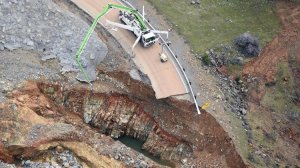The massive failure of the Oroville Dam’s main spillway in February involved two dozen potential design and maintenance problems, including thin concrete, inadequate reinforcing steel and weaknesses in the foundation, a panel of engineering experts reported Wednesday.

A forensic investigation team said it was issuing a preliminary list of causes so that engineers do not repeat the problems as they rush to fix the spillway before the next cycle of rains begins in November.
The two-page report does not identify what initiated the failure along the 3,000-foot chute that was used to drain the reservoir during massive winter storms. But it makes clear that the spillway is structurally too weak to handle the massive loads it sustained when dam operators opened the spill gates.
“The list is long,” said David Gutierrez, one of state’s top dam safety experts who retired from the Department of Water Resources after 37 years and is now consulting on the safety investigation. He said that not all of the 24 factors will likely be cited as causing the failure, but he added that no single problem likely caused the failure either.
Read the full story on LATimes.com.






